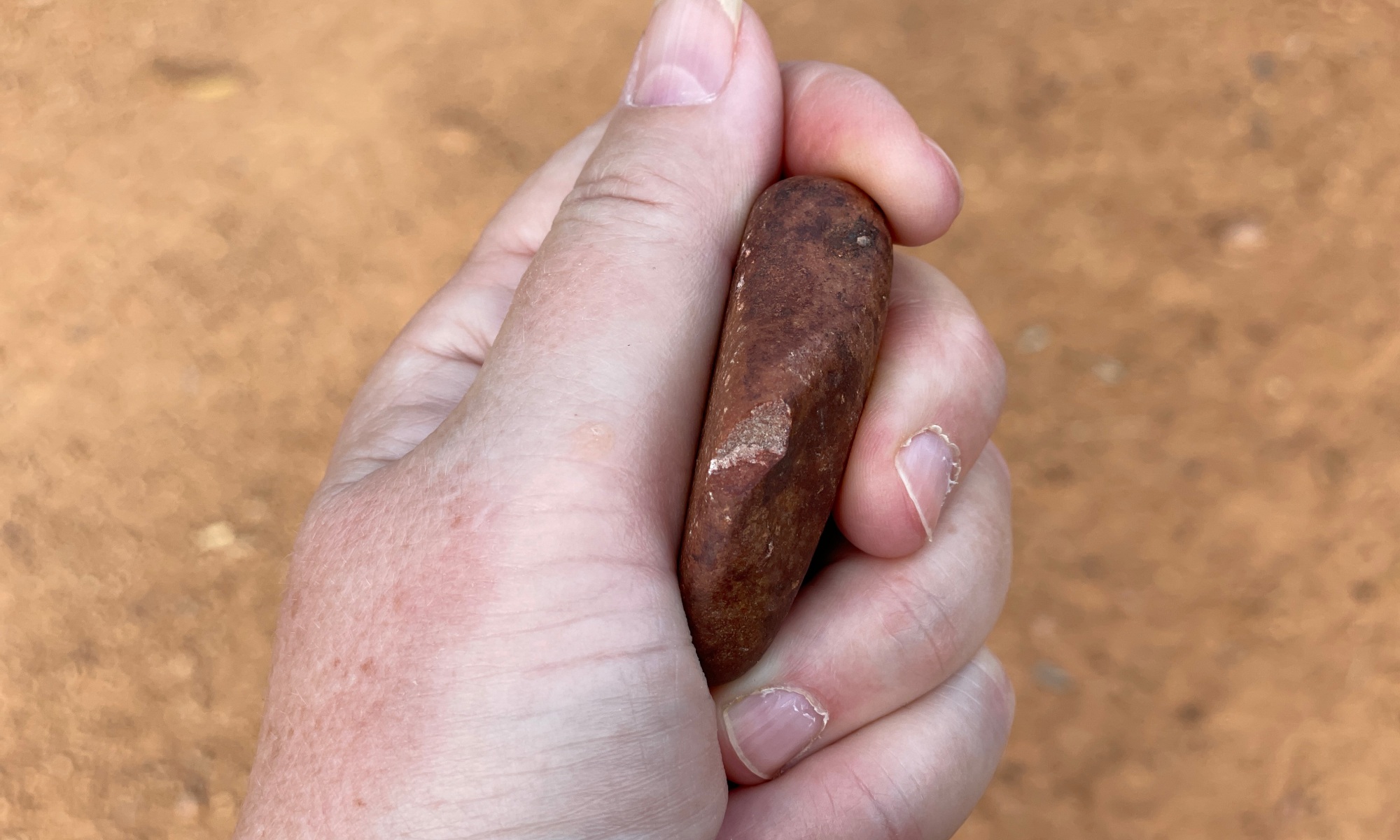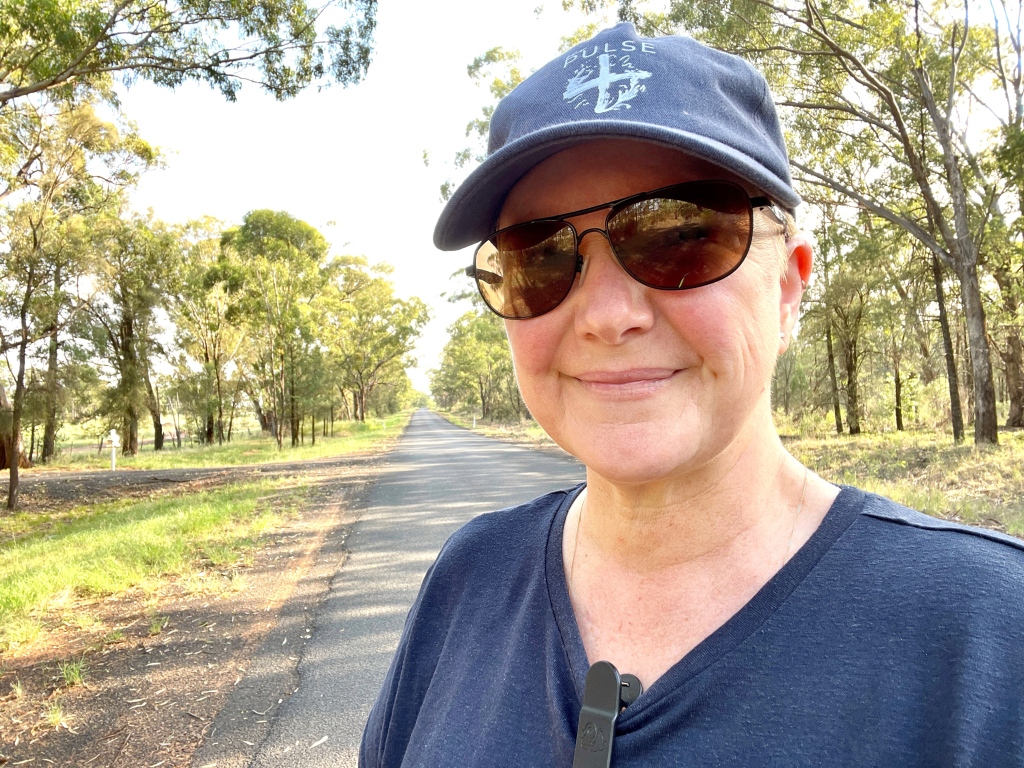
After a couple of days of late summer temperatures in the high 30s, I was looking forward to my weekend walk with my dog, in ‘walking temperatures’. If I was going to put in an order for a day like this it’d be something in the high teens, with a light breeze, and no mosquitos or flies. On top of warm days and nights, it’d been a week of big ideas, animated conversations, and work pressures that left my brain churning. These walks are way of processing and forgetting as I zoom in on the detail of the territory I’m walking within—the tiny, tufted spines on prickly pear fruit, the feathery heads of roadside grasses bowing in the wind, and a fallen black and white feather with the palest smudge of bronze.
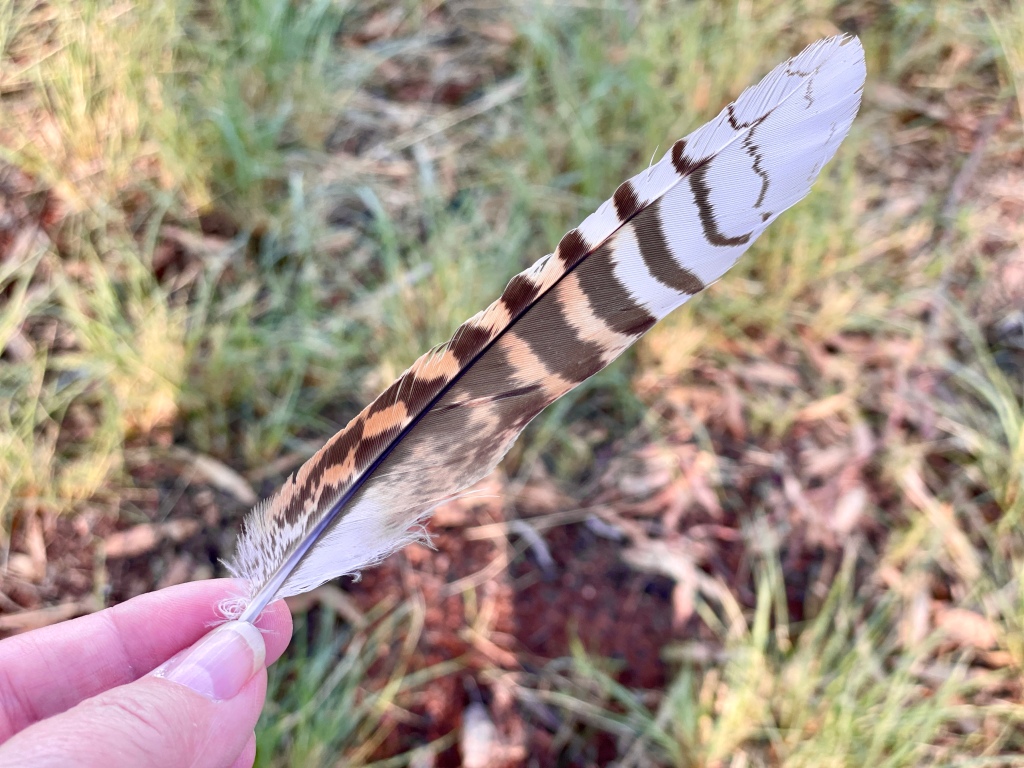
…a blistering confluence of ideas and events that has left me agitated.
My week was filled with conversations that I was either an active participant in or witness to, on topics as broad as walking as a creative process, the impact of generative artificial intelligence on the arts, and regenerative tourism. Between these formal talks, were social media chats about the intimacy of daily connections with natural environments, and the tragedy of lost soundscapes. In the background was news of Taylor Swift’s Australian tour—the private jets, accommodation cancellations, sequins and general hysteria, along with bushfires and war.
Phrases such as living ‘in the shadow of AI’[1], ‘flourishing without purity’[2], and the urgent need for ‘a mindset shift, systems change and a reframing of our connections’[3] with each other, the natural world, and ourselves have been looping through my waking and sleeping brain. To make things worse, I’ve also been crafting grant application project briefs, in 50 words or less, for an agroecology artist residency project. My mind has been filled with buzz words in the vague word economy bureaucrats desire.
I’m sure there have been other weeks where my exposure to ideas and newsworthy events have chafed with my own beliefs and values. This week, the rub felt raw—a blistering confluence of ideas and events that has left me agitated.
Invasion and decline

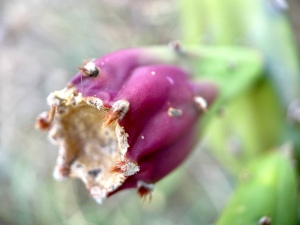
Going back to my Saturday morning walk and those things I noted—the cactus, the grasses, and the bird who lost a feather— only one of these is native to Australia. My periurban landscape on the edge of a major inland city, with its trees, shrubs, grasses, herbs, birds, insects, fish, amphibians, reptiles, and marsupials is not a pristine environment. It hasn’t been for a long time. Casuarina groves and box woodlands include an understorey of prickly pear and African boxthorn, most of our roadside grasses are introduced species escaped from farms and are often habitat for flourishing exotic flowers from illegally dumped garden rubbish. Dams and rivers are full of mud-churning European carp, while cats and foxes roam widely preying on small mammals, lizards and birds. At home, a pair of Eurasian blackbirds have taken up residence in my hybrid garden alongside the native flock.
Extinctions are holes torn in the fabric of life, and Australia is ragged from so many species ripped out.
Invasive species reportedly cost the global economy over $423 billion every year, with costs quadrupling every decade since 1970[4]. The Australian Invasive Species Council has said over 80% of Australia’s mammal extinctions to date have been caused by invasive species—a percentage likely to climb in the next 20 years. How do you turn back that tide of biodiversity loss?
In my lifetime, studied animal populations have seen an average relative decline of 69% since 1970. As The Living Planet Index[5] explains, this does not tell us anything about those populations that haven’t been studied, the number of individuals, species or populations lost, or even the share of populations that are shrinking. The 2023 Australian Invasive Species Council report on extinctions[6] opens with: Extinctions are holes torn in the fabric of life, and Australia is ragged from so many species ripped out. It’s a sobering read and the thought of the altered or lost soundscapes that are part of this seemingly unstoppable extinction, drives me as an artist who uses sound in my practice, to keep recording and documenting all I can here, in my backyard of Regional Australia.
Attention and connection
In prepping for my online talk with Dr Andrew Frost on the impact of AI on the arts, I came across the work of Refik Anadol, a Turkish-born, Los Angeles-based media artist. His installation work ‘Living Archive: Nature’, is described as a multisensory experience, combining visual, sound and scent elements of different ecosystems created by a generative AI program and based on data from the natural world. Anadol says of the work: …the piece is meant to move AI beyond its human-based training to bring people closer to nature and bring urgency to the need to protect it. We are hoping to inspire an immediate and urgent need to preserve nature. We all are so distant from nature. Our goal is to make people love and respect nature through AI and appreciate the intelligence of nature in order to fight for its preservation. The time is now for action. We have no more time to wait.[7]
Anadol’s work appears to be big, flashy, colourful, and is most probably immersive by digital standards. There’s nothing fundamentally wrong with what he says about it either, but I believe it’s completely out of context with what is really happening in the more-than-human world and ways in which we might meaningfully connect with it.
…an intimate, personal experience with an energy force I walk on every day.
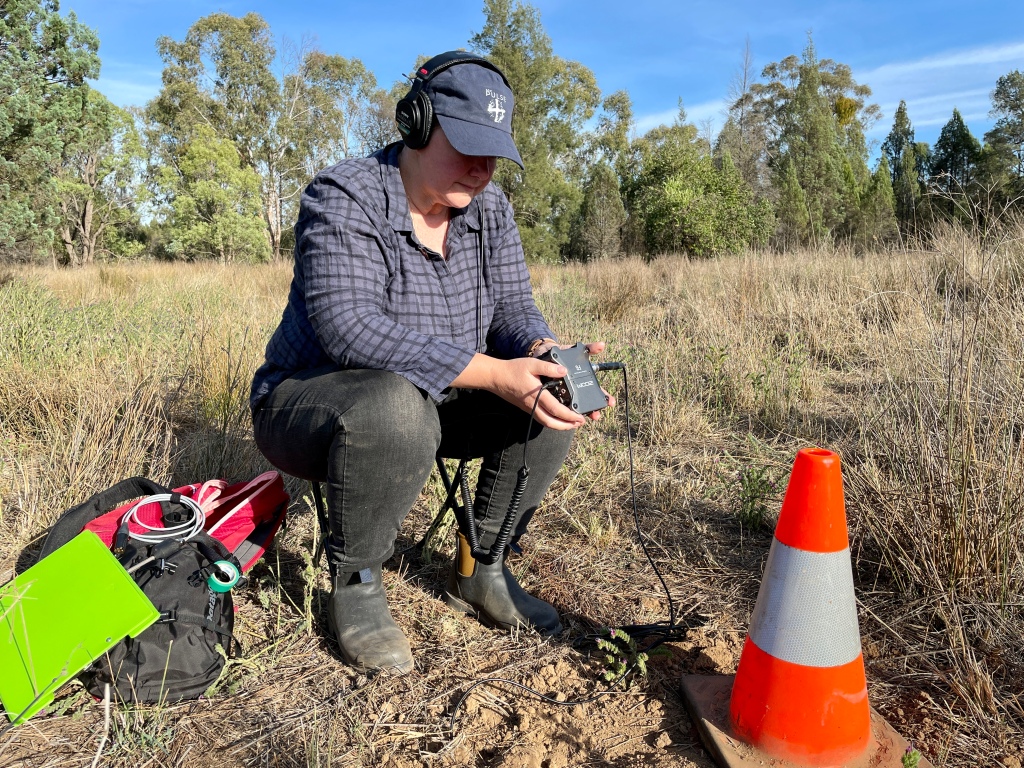
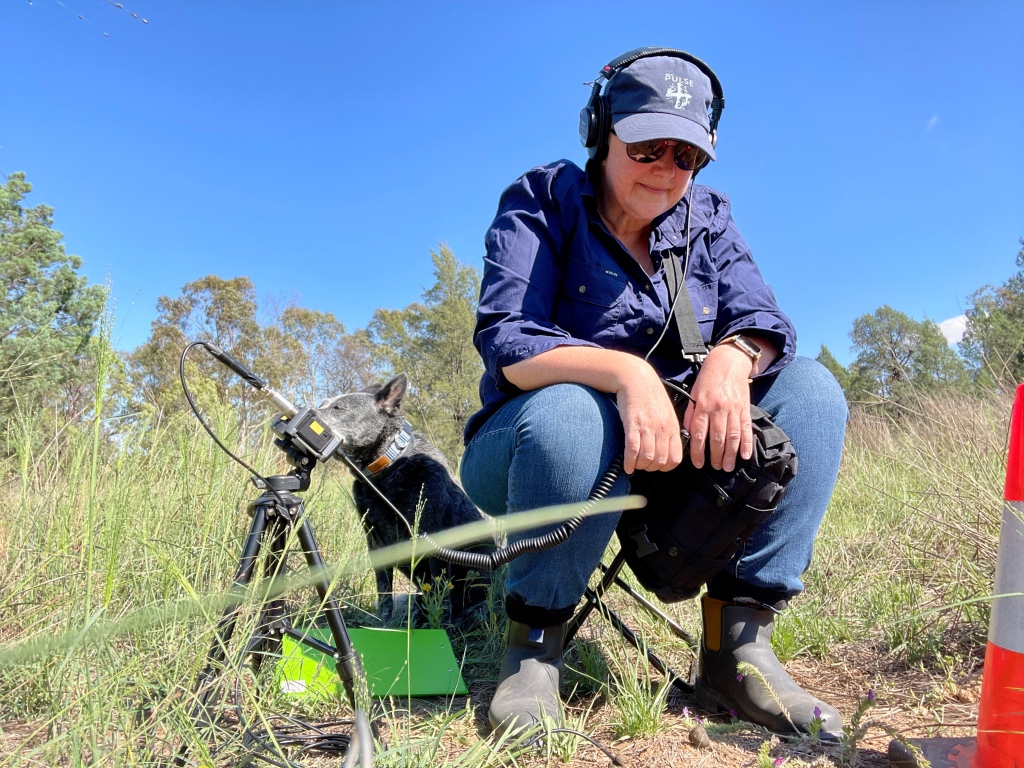
Using specialist microphones to listen to the soils on my periurban block west of Dubbo NSW Australia. At left in mid-November 2023 and at right, mid January 2024.
The two months I spent this last summer listening to life beneath my feet, in soils that went from being quiet, hot, dry and floury to crackling with life after drenching rain, was an intimate, personal experience with an energy force I walk on every day. It was completely immersive. Sitting still beneath vast cloudless skies in baking temperatures and in the rain, I silently witnessed native, blue-banded bees and microscopic hoverflies supping the nectar of introduced species, black ant colonies preparing for torrential rain, small woodland birds fighting over territory, and kangaroos grazing and resting nearby. Walking to the listening site repeatedly over weeks, I watched Narrow-leafed ironbark buds burst into creamy sprays, and native and exotics plants—almost all considered ‘weeds’—pushing their green, pinprick shoots through the damp earth before growing rapidly in hot, moist conditions, until the bare earth was once again cloaked in green[8]. All of this is made possible by life below ground.
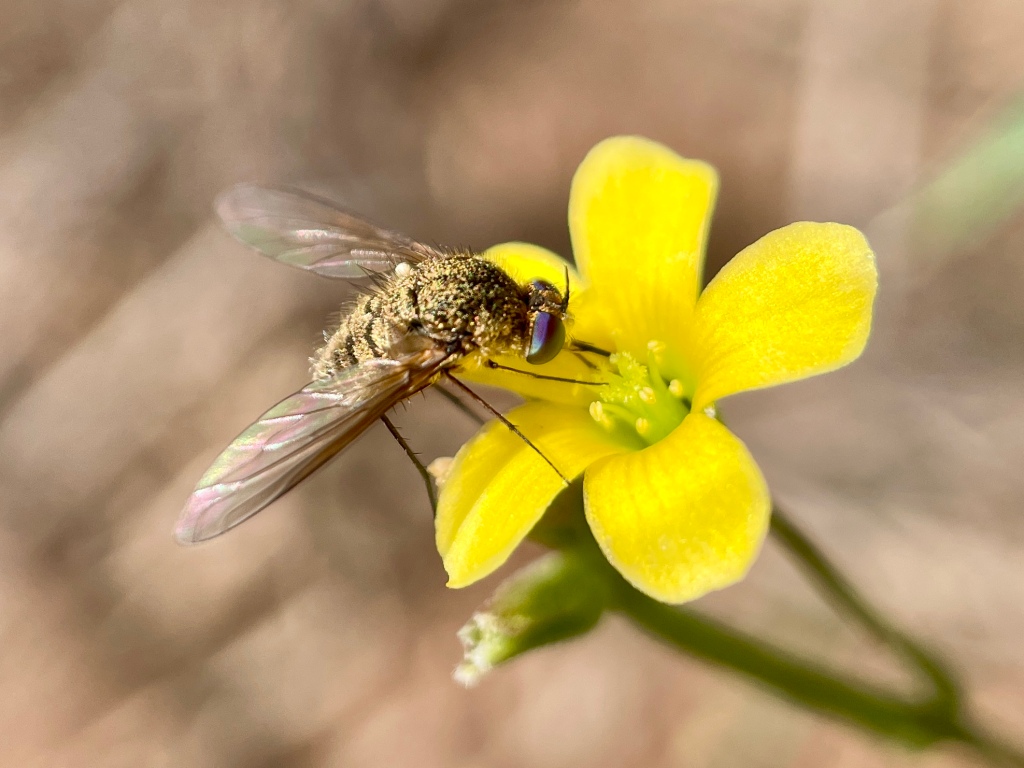
Does Anadol have it right? Do we need a big, flashy, colourful AI version of nature to get our attention? What about the small ‘uglies’ of our natural world, often unseen but playing essential roles in the health of our world—the microbes, the earthworms, ants, fungi, flies, small birds, lizards, and bats. Is the short-term fix of creating habitat for humans by building medium and high-density housing on the last remaining greenspaces of our capital cities or the sprawling, treeless estates of cheaply built, beige/grey houses on the edges of regional cities, the answer to creating a flourishing world where human and more-than-human prosper together? These housing developments are often built on land considered to have no value to us in their natural state—’unproductive’ land.
Words and meaning
When I think about what ‘regeneration’ means, like the words ‘sustainable’ or ‘resilient’, I have to check what the definition is. I’m just not sure of their meaning anymore. They’re becoming hollow words as growth-focused, productivity-driven industries and sectors look for new ways of ensuring business as usual in a rapidly changing world. I feel manipulated. If ‘generation’ is the production or creation of something, what is ‘regeneration’? Are we just producing or creating the same thing, over and over and over?
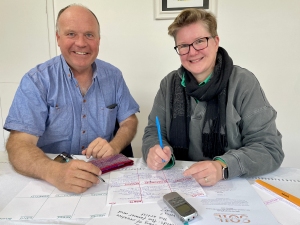
My co-collaborator on the agroecology artist residency project, SOIL+AiR creative future landscapes[9], is an agroecologist who many refer to as a farmer. He’s a fourth-generation farmer in his district, but his family are farming in a radically different way. His name is Bruce Maynard. Bruce has a few sayings that have been starting points for our conversations, including— Healthy people, landscapes and communities are achieved at ground level…and I’m about designing futures that are not just sustainable, but desirable and plentiful. This means diversity.
Will we be symbiotic cohabitors or destructive dominators?
So, what does Bruce mean by desirable? I see desirable as meaning a healthy world for our descendants, a place to flourish in a state of homeostasis, at one with our environment (human and more-than-human). It’s up to us to decide what we value (desire), and allow those values guide our actions. It won’t or can’t come from the top down because governments, world-wide, have been much too slow to act. Bruce resists using the terms ‘regenerative’ and ‘sustainable’ when talking about his farming systems because they don’t adequately reflect what he’s trying to achieve.
Speakers at the international online regenerative tourism summit this week hinted that this was possibly going to be the case for their industry too, but ‘regenerative’ was used repeatedly anyway. What probably made more sense was talk of systems change. By focusing on the desirable, we come back to what we value and how we picture our place on Earth. Will we be symbiotic cohabitors or destructive dominators? The diversity outcome is up to us too, although what we’re working with on the back of escalating biodiversity loss is reports of accelerated ecological collapse by 2030[10] .
Like the proverbial freight train, it’s going to be impossible to stop it in only six years. All the de-carbonising of our economies, and the rewilding and rehabilitation work being done is commendable but not nearly enough. I wonder if there is the option to rethink this. Can we live with the compromise? Knowing we won’t get back what we’ve already lost, is it possible to create new, symbiotic ecologies in places of extreme degradation— where suitable, adaptive non-native species are no longer ‘weeds’, but groundcovers for bare earth or replacement habitat for native species that might be reintroduced?
Questions are good
The natural world is self-ordering, but how do you self-order in a world that’s becoming increasingly destabilised? We’re in a polycrisis[11] that like the little black ants I encountered while listening to my soils, is attacking us on all fronts. It overwhelms us, throws up many wicked questions, and has a stupefying effect on many of us—even those advocating for change.
At the end of this week, I’m left with many more questions than answers. Questions are good. I feel purpose in finding ways to reconsider the way we think, feel, and act within the world. Art can open minds to experiencing things in new ways, offering new perspectives, breaking down barriers, transcending the politics of the day, and enabling us to feel more connected to what Glenn Albrechdt calls an earthly symbiotic life.
As I ruminate on this week’s confluence of ideas and world events, I’ll continue walking—it feels like some sort of positive action. There’s often a rhythm to these walks that makes me feel more in-sync with the ground beneath my feet, the whisper and chatter of the trees above me, the rise and fall of birdsong, and the warm breath of late summer…now that it’s no longer choked with the acrid smoke from burning piles of bulldozed trees and understorey on a newly cleared block down the road.
This new series of blog posts will be found under the Category – Sumbios, with thanks to Australian environmental philosopher, Dr Glenn Albrecht, for his ideas of what it might mean to live in The Symbiocene.
Links to some of my current projects:
#SoundOfSoils
SOIL+AiR
Vaticinor
Kim V. Goldsmith is an Australian multi-disciplinary environmental artist working in an interdisciplinary practice across rural and regional territories. Her work is exhibited and presented in exhibition, festival and online across Australia and internationally.
[1] Writer, media lecturer and AI advocate, Dr Andrew Frost in an Orana Arts Studio Co!lab Talk with me on Zoom, 21 February 2024
[2] Referenced by Dr Perdita Phillips in an Australian Walking Artists hybrid talk event on 18 February 2024, as part of the Australian Walking Artists exhibition I’m part of at Articulate project space, Sydney (10 February – 3 March 2024)
[3] Researcher and strategist in the tourism and hospitality sector, Anna Pollock speaking at The Tourism Colab Regenerative Tourism by Design Virtual Summit, 21-22 February 2024
[4] https://invasives.org.au/media-releases/423-billion-per-year-and-rising-the-cost-of-invasive-species-revealed/
[5] https://ourworldindata.org/living-planet-index-decline
[6] GONE: Australian Animals Extinct since the 1960s – https://invasives.org.au/wp-content/uploads/2023/08/Extinctions-Report.pdf
[7] https://www.nbcnews.com/tech/tech-news/davos-art-installation-looks-bring-people-closer-nature-little-help-ai-rcna134277
[8] #SoundOfSoils project – https://eco-pulse.art/projects/the-dirt-on-sos/
[9] SOIL+AiR creative future landscapes – https://eco-pulse.art/soil-air/
[10] https://www.nature.com/articles/s41893-023-01157-x
[11] What is the polycrisis? https://www.weforum.org/videos/experts-explain-adam-tooze-what-is-the-polycrisis/#:~:text=This%20term%2C%20originally%20coined%20by,other%2C%20exacerbating%20already%20difficult%20circumstances.

